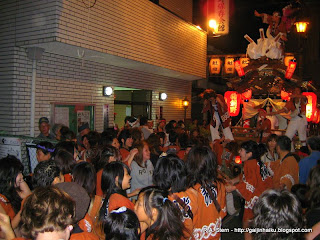Open Theme: Japanese Ketai Identity
As part of a larger inquiry, I've been talking to Japanese students about their keitai (cell phones). My curiosity in the supposedly mundane follows the anthropological tradition of investigating things people do in their everyday lives, and with keitai use estimated at a staggering 90% adoption rate in Japan (see Ito et al below), it certainly qualifies.
In the United States there is a strong association of material culture display and personal identity expression that dance around with voyeuristic intentions. Showing off one’s identity reaffirms it through the process of making it known to others. It’s not hard to imagine that in Japan, a country where who you know helps define who you are (see Bestor below), that the same is true, or even more so. On the contrary, this is not entirely so.
Although shopping bags from expensive stores, by comparison, are often used as a form of self-labeling like in the United States, keitai hold an interesting juxtaposition of private public space. Individuals I have talked to all consider their phones a private utility that holds no explicit intention for expressing meaning to other people. Most ornaments (often called keitai straps) or decorations have private histories for the owner, and possibly close friends, but are usually imperceptible to other individuals. One young lady, for instance, admitted she only kept one of her ornaments because it was expensive, while there was nothing remarkably telltale about it visually. Many individuals keep decorations that friends have gifted to them, while others select them based on personal choices such as a favorite color, or to bring luck.
Keitai have also been discussed in more depth by Mizuko Ito et. al in Personal, Portable, Pedestrian: Mobile Phones in Japanese Life. Also, Ted Bestor (Tsukiji) and Dorinne Kondo (Crafting Selves) both discuss personal identity and its relation to networks and community.
Religion & Tradition: A Blended Perspective
Nestled in a place called Momodani is Miyukimori Shrine, home to the tutelary deity of the area formerly called Ikaino Village. By some accounts, the famous 4th century Emperor Nintoku is also a diety of the shrine, and is an important part of the historical flavoring of Ikaino. A mixed history of native descent, Korean immigration, and bureaucratic re-organizations have changed maps, place names and even moved entire rivers in this place. Today the remnants of Ikaino Village persist as traditions through the Ikaino Preservation Society, and the word Ikaino has since gained multiple meanings from its winding history (course lecture, Dr. J. Hester, Kansai Gaidai).
Miyukimori Shrine
Miyukimori Shrine and the Ikaino Preservation Society have a relationship that blurs the lines of secular and religious1. To the Western mind these terms are mutually exclusive categories, a tendency that is as problematic as it is helpful. The role of Shinto shrines in Japanese life, however, is integral. Neighborhood solidarity, individual religious needs, record keeping, and annual Shinto rights are but some of the many roles a shrine attends to for Japanese society.
This annual festival is held throughout Japan celebrating 3, 5, and 7 year olds.
Although performed as Shinto ritual, it is not necessairly consider a religious practice by those who attend.
While the Ikaino Preservation Society concerns itself mostly with tradition, it relies upon the Miyukimori (and other purely secular institutions) for maintaining everyday neighborhood connections, and also utilizes it as the nexus for traditional displays such as the aki matsuri (Fall festival). The shrine complex provides storage for the danjiri (the large portable shrine which itself transports the shrine deity around the neighborhood), space for festival merchants, and priests for religious rights and prayers. The interactions of individuals with the shrine are often transparent, perhaps seen in a hitherto glimpse as someone is seen praying at the offering box during matsuri, or anytime it is appropriate to daily life. Their association with the shrine, however, is far more public as Japanese shrines serve geographically bounded parishes, sometimes including multiple neighborhoods.
The danjiri stops outside the Preservation Society headquarters.
Neighborhood solidarity is displayed prominently through happi coats worn by participants.
Although the Western penchant for separating the secular and religious can often cause difficulty in understanding how the Japanese view their own relationship to the shrine, we ought to recognize parallels. Historically in the US and Europe alike, Christian churches served geographical parishes uniting communities around religious centers. US constitutional doctrine aside, I find it no far reach to imagine Western thought once being very much without these rigid categories. I wonder just how much the US separation from England has influenced this contemporary mode of thinking around the world, and where are we taking it in the future.
1: For more discussion on ritual in everyday life in Japan see Ian Reader, Ceremony and Ritual in Japan.
Gender in Japan: Something about tsureshon?
Recently I became aware of the term tsureshon. Litreally translated it means to urinate in a group. In Western countries there is a stereotypical association of women going to the restroom in pairs. This phenomenon is not alien to the Japanese mind, and the concept is nearly identical. Extrapolating on the word thus illuminates a more broadly gendered framework of thinking about how women relate and communicate in contrast to men; with intimacy, collaboration and emotion being discerningly more feminine in this context.
Men in the act of tsureshon.
Source: 漆黒のコラボレーション!
Kansai Gaidai’s current ad campaign “GO FOR it !”, works as a visual echo of the broader tsureshon implication of women. For a university comprised of nearly 70% females (course lecture, Dr. J. Hester, Kansai Gaidai), capitalizing on this imagery may make the most sense for attracting new students. I can recount instances watching my female Japanese friends interact: tickling, or playfully pushing each other, crowding on benches or sharing seats to let male friends have their own chair, and walking closely together as if parts of a single mind and body. Young men are not exempt from similar behavior, but more often they seem to take up a wider stance and command a larger area around themselves when with friends.
I’ll admit my occidental bias may be seeping in here. Though, I cannot help but wonder that perhaps these similarities between Western society and Japanese society are not merely my selective perception. There is a long history cross-cultural influence and today instantaneous global media distribution is a formidable reality. And parallel social development has been shown in many societies without prior contact, raising questions about our genetic predispositions to societal thinking. So is it really so farfetched to be seeing my own cultural gender expectations and stereotypes, starring back at me through a mirror of Japanese college life? Although some of the faces may be Japanese, the gendered imagery is overwhelmingly familiar.
Indirect Globalization: The Eisa Festival
at
21:56
Sunday, November 1, 2009
Labels:
Eisa
,
globalization
,
Okinawa
,
Ryukyu Kingdom
,
tradition
Within Japan each year Okinawans gather to celebrate their Ryukyuan heritage through a series of festivals centered on the Eisa folk dance. These events take place in multiple locations across the country, notably in Okinawa City, Osaka and Tokyo. With them come the dancers, singers, performers and revelers to impart their traditional music, dance, food and hospitality to all who’ll partake.
As other students of visual anthropology have noted[1][2], the colorful costumes and vibrant dancing is the centerpiece of the festival. The culmination of the festival is a final dance in which the audience is welcomed to participate. Local Japanese, Okinawan descendents and non-Japanese foreigners as well all gather. Smaller parties also take place under the shaded tents of private groups. Here, perhaps, is where the real sharing takes place though. Joyful revelers playing music and dancing may welcome any willing and daring enough to participate in the celebration, and attempt the simple but lively hand movements of the dance. Two of my fellow students shed their inhibitions and joined such a group who invited them, and so a part of not just Japanese culture, but Okinawan culture will be taken home with them.
The blending of cultural elements does not come just from the imparting of Okinawan culture upon Japanese and foreign festival goers though. Looking around evidence of an ebb and flow in both directions can be seen in many forms as well. For instance there's the family that uses a Peanuts inspired picnic placemat from Baskin Robbins blends Japanese kawaii (cute) culture with US cultural references and products. Turn around and you can see Okinawan dancers posing for a picture with a Canadian international student, flashing the quintessential V-sign so popular in Japanese photographs. All of these elements culminate in the Eisa Festival as more than just a celebration of Okinawan culture. In these respects it also shows the many ways in which culture is being shared locally, and internationally.
More information on past Eisa Festival events, and images, can be found courtesy of Okinawa Bunko (in Japanese).











